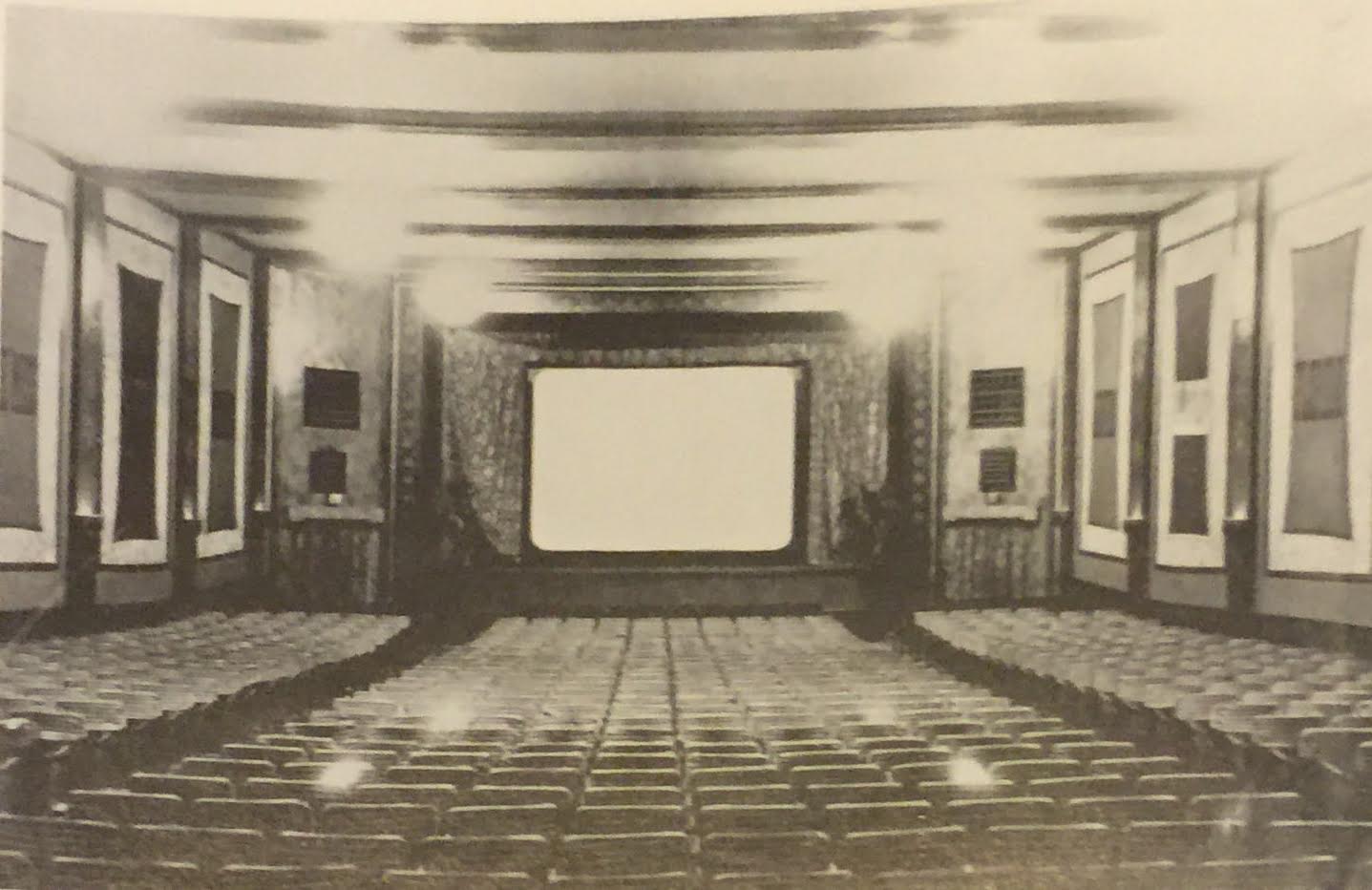
Meet my father-in-law, Bob Coats. He is a retired veteran. He’s been a CPA for over 50 years. He is a good husband. He is a good father and grandfather. All of those things are awesome….yet every time I am around him, I always end up asking him about his time at the Tiger Movie theater in Auburn, Alabama.
His dad, Gus Coats, was the manager of the Tiger theater from the late 1930s until 1959. So it is safe to say that Bob grew up in his dad’s movie theater. After years of asking Bob lots of Tiger theater questions…I finally figured it was time to share this information. So here….after eleven plus years of questions is my “interview” with Bob Coats.
Cogerson: So how did your dad end up being the Tiger theater manager in Auburn, Alabama?
Bob Coats: My dad actually was a vaudeville stage manager in Chicago. As vaudeville started to fade out many of the vaudeville theaters became movie theaters. So it was a pretty natural transition for him to move from vaudeville theaters to movie theaters. He went from Chicago to the Empire theater in Montgomery, Alabama to the Tiger theater in Auburn.
Cogerson: So did your dad get to know any famous performers during his time in vaudeville?

Bob Coats: Yes he did. Probably his best friendship was with Jimmy Durante. Durante had a very popular radio show and television show. At the end of each show Durante would say “Good night, Mrs. Calabash, wherever you are.” For years it was a great mystery as to who Mrs. Calabash was and why Durante said it. My dad hinted that Durante shared the Mrs. Calabash secret with him.
Cogerson: So what are your first memories of the Tiger theater?
Bob Coats: I remember when I was around 5 years old (1944), my dad would grab our red wagon, load up me, my older brother Gus and our Boston bulldog Major, and drag us over a mile to the Tiger theater. Once we got to the theater, Gus (my brother), Major, and I would play hide and seek in the theater as my dad would be checking the prints of the movies. Eventually Major would get bored and head to the seats in the front of theater where the kids usually sat and find the used bubble gum that was always laying on the floor. Every time we left, our mother would say…”Keep Major away from the gum”…and every time we came home his head and whiskers would be covered in gum. Every time my mom would have to clean Major up…. including using alcohol to get his whiskers clean…. which Major did not like at all. As I got older playing time was replaced by working at the theater. From 1944 to 1961 I went from playing hide and seek to being the marquee person to running the concession stands to the assistant manager of the Tiger theater.
Cogerson: Was the Tiger theater the only movie theater in town?

Bob Coats: Auburn had two theaters back then…. our Tiger theater and the War Eagle theater. Our theater was part of a chain that was based in Atlanta, Georgia. The War Eagle theater was an independent theater. Back then the studios had contracts with the theaters. Because ours was part of a chain the studios were more interested in signing contracts with the Tiger theater than the War Eagle theater. We ended up with contracts with Paramount, Warner Brothers and MGM. The War Eagle had contracts with RKO and United Artist. So, if you wanted to see the new Bob Hope or Bing Crosby movie you had to come to the Tiger theater…. if a new Disney movie came out you had to see it at the War Eagle theater.
Cogerson: How long would it take for a new movie to reach Auburn?
Bob Coats: Back then movies were released differently. There was no real opening weekend like you see today. Back than a new movie would open in the big cities. Then slowly the movie would reach the rest of the country. The closest big city to us was Birmingham, Alabama. About a month to 6 weeks after it played in Birmingham it would finally reach Auburn.
Cogerson: Wow…today even the biggest box office hit is pretty much out of theaters in 6 weeks. How did you combat the delay of it getting to Auburn?
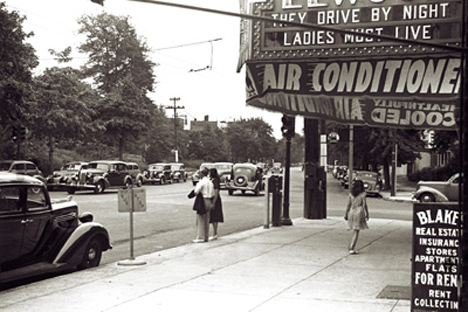
Bob Coats: Not many people had the time to drive to Birmingham to see a new movie. Plus, the movie theaters were one of the first places to have air conditioning. We used to have a banner hanging in front of the movie that advertised about how nice and cool it was in the theater. Being in the deep south that was a huge advantage for us in the summertime. The draw of air conditioning far outweighed the need to see a new movie miles away. Our theater had used cooling towers as air conditioning units…which were huge and very loud. Those cooling towers had excess water trays that had near-freezing water in them…..during the summer we would drop a couple of watermelons in those water trays…and about two hours later you would have the best tasting, perfect temperature watermelons ever! Just one of the benefits of working at the Tiger theater.
Cogerson: How did Paramount get the movie reels to your theater?
Bob Coats: Well, my dad’s theater was part of a chain. That chain had a guy whose job was to pick up and drop off the movie reels and promotional materials on a weekly basis. He had a key to our theater and would drop off and pick up the reels in the middle of every Thursday night or Friday morning. We never saw him…. but we knew when he had been in the theater…. because the old stuff was gone, and the new stuff had arrived. The night before he was due, we had to collect all the promotional materials that Paramount had sent out to promote the movie and get them ready for pick-up. This included all the photos they sent out, the movie posters, and all other items related to the movie. The only thing we could keep was the 24-sheeters.
Cogerson: What are 24-sheeters and why did the studios not want them back too?
Bob Coats: 24-sheeters were used for outdoors promotions. They would arrive with 24 individual sheets that together would make one giant billboard poster for an upcoming movie. We would paste all the sheets together on the side of the building…it was basically like putting a puzzle together. Generally, they would stay up for about a month……until a new 24-sheeter would arrive. The only reason the studio did not want them back was because they were trash when it came time to take them down.
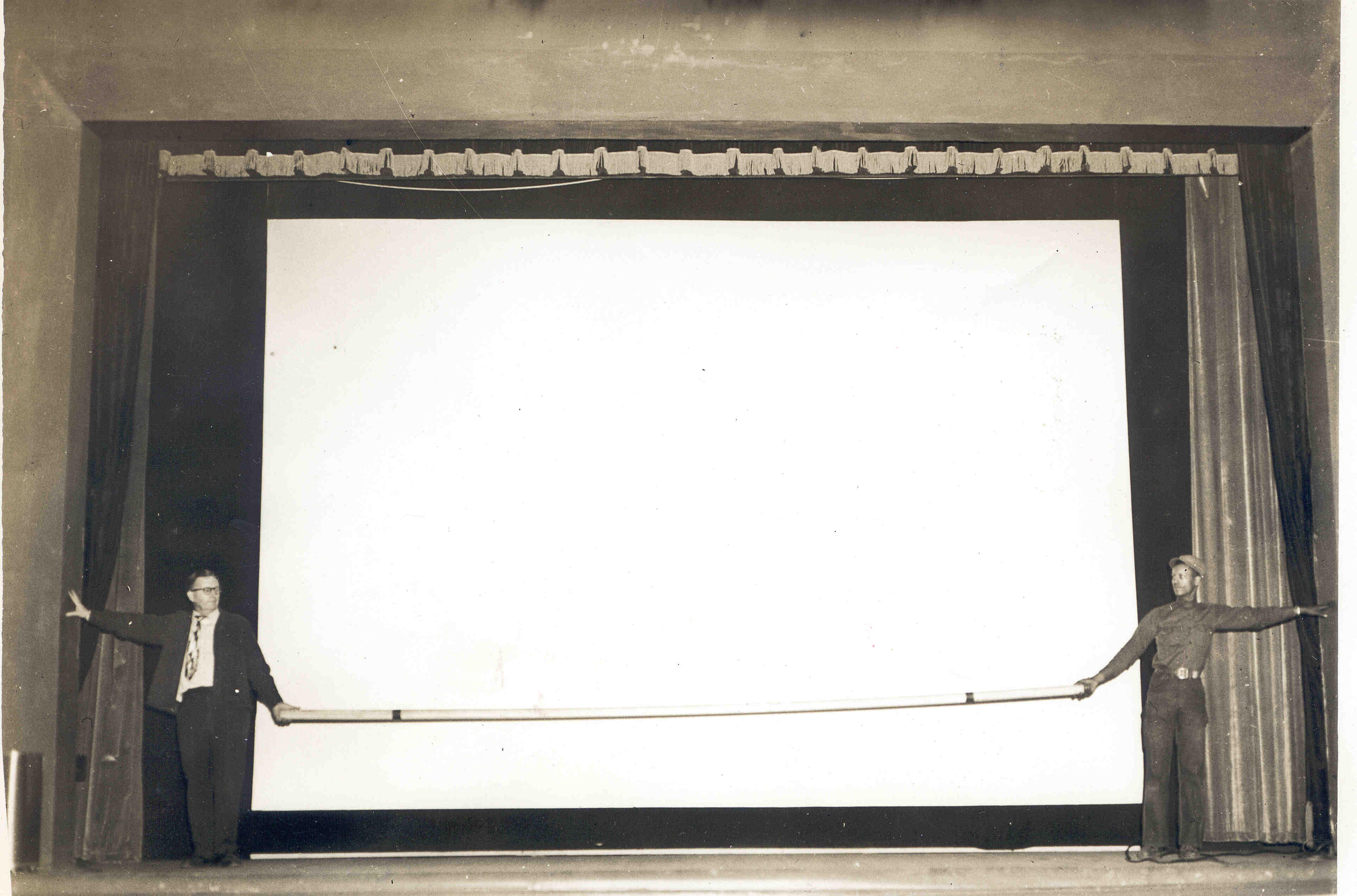
Cogerson: So, you only had a movie for a week and then it was gone? What if it was a big hit and the demand was still great?
Bob Coats: We usually had so many showings that anybody who wanted to see a movie had the chance to see it Friday through Tuesday. Typically, a new movie only played Friday night, Saturday night, all day Sunday, Monday and Tuesday. On Wednesday and Thursday, we would run a second run movie. A second run movie would be a movie that already had played in our theater…and was usually a year or two old. However, when Bing Crosby and Bob Hope had a new movie…those movies played all week…. we called them all-weekers. Normally Friday and Saturday mornings and afternoons belonged to the kids….and we would run B Westerns and serials. Saturday was when Gene Autry, Roy Rogers, Randolph Scott, and Trigger ruled. The Three Stooges were also very popular. Some of the kids would arrive in the morning and sit through all the showings of the movie….in many ways the theater was like a baby-sitter service.
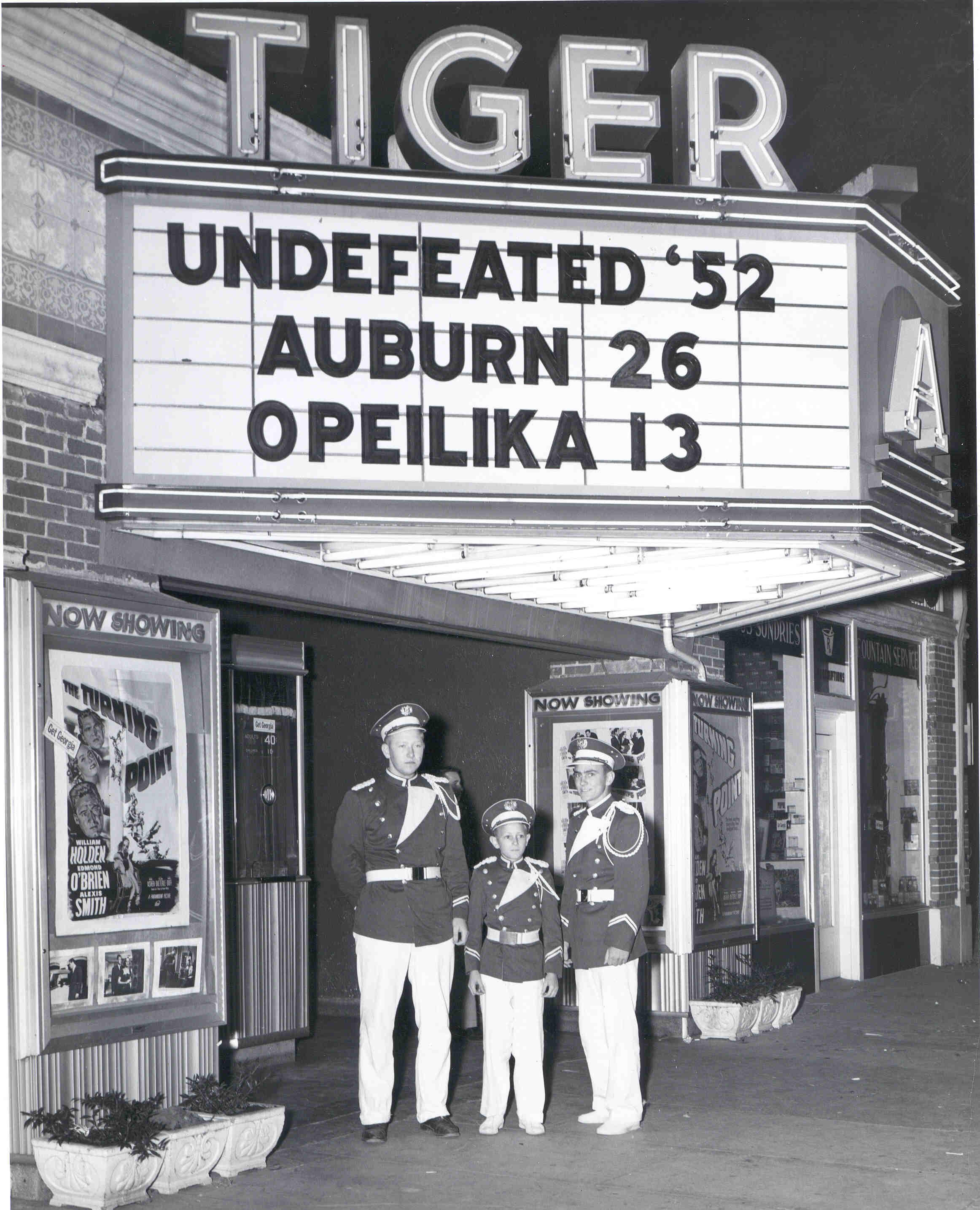
I liked when Crosby and Hope had a new movie…because it meant I did not have to change the marquee as many times. Changing the marquee was one of my main jobs at the theater and normally in a week I would have to change the marquee three to four times a week. I earned 50 cents a hour changing the marquee. We even posted the high school and college football scores on the marquee. One of the first rules I learned about doing the marquee signs was the “one thumb width” rule. Between each letter you had to leave “one thumb width” of space. If you did not follow that rule…the marquee would look terrible. Generally, it would take me about 40 minutes to do each side of the marquee.
Cogerson: In this picture of the marquee – why is Opelika misspelled?
Bob Coats: Ha, ha, ha…. that was a sly insult at the rivals in the next town over. They were so unimportant; we didn’t need to spell their name correctly.
Cogerson: Sounds like Friday and Saturday afternoon would get crazy when you got invaded by all the kids showing up.
Bob Coats: Well….the kids did not come empty handed. They normally brought enough money to keep the concession stand hopping. A dollar could get you through the whole day back then. The concession stand was another one of my main responsibilities. Back then…just like today…. concession sales is where the money is at in theaters. I have many fond memories at that concession stand. Me and a buddy used to see who could get the popcorn in the box the fastest….gotta admit he had better technique than mine. He could take a flatten box, and with one hand pop it open and seal the bottom of the box while he scooped popcorn with the other hand. I remember when I was going to Auburn University, I used to have set up the concession stand and make popcorn before going to class. Later, people would smell popcorn on me and want to know why I did not bring any for them.
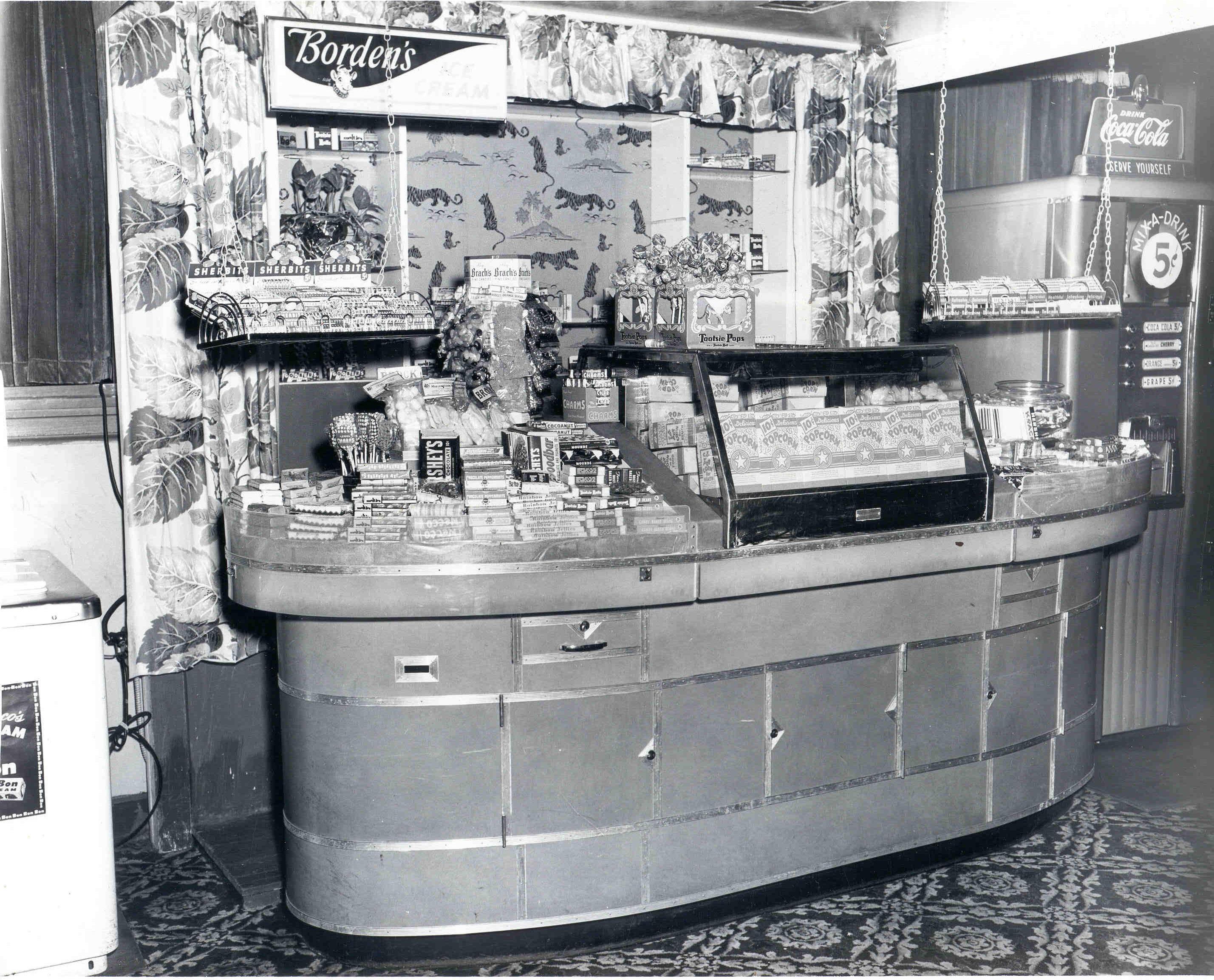
Bob Coats: I remember one little boy who turned out to be a very clever thief. Every time he came to the theater, he brought an empty tennis ball can. We could not figure out what he was doing with it. Finally, one day he was spotted sliding candy from the concession stand into the can. When we opened the tennis ball can we found the candy and at the bottom of the can was a bunch of cotton. That way the candy made no noise when he slid the candy into the can….and the person behind the counter never heard the candy falling into the can. I imagine he had to spend some extra time in church for that one. Speaking of church…. on Sunday we were allowed to be open, but we could not open until 1 PM and we could not show movies from 5:00 PM to 7:00 PM. Basically, any time you could be at church services the movie theater could not be open.
Cogerson: One of my favorite movies is called Cinema Paradiso….that one is about a movie theater in Italy right after World War 2….which is the same time frame when you were at the Tiger theater. In that movie…. fire in the projectionist booth was a great fear. Did the Tiger theater ever have any issues in the projectionist booth?
Bob Coats: Thankfully we did not. But the film celluloid was very, very flammable. Our projectionist booth was fireproof. It had crash bars and no wood. It was very, very loud and very hot. Carbon arcs provided the light for movies. The projectionist would strike the arc by turning on the power and then striking the carbons together. The projectionist had to maintain the arc by using two motors in a device called a lamphouse. The carbons burned at about 6,000 degrees.
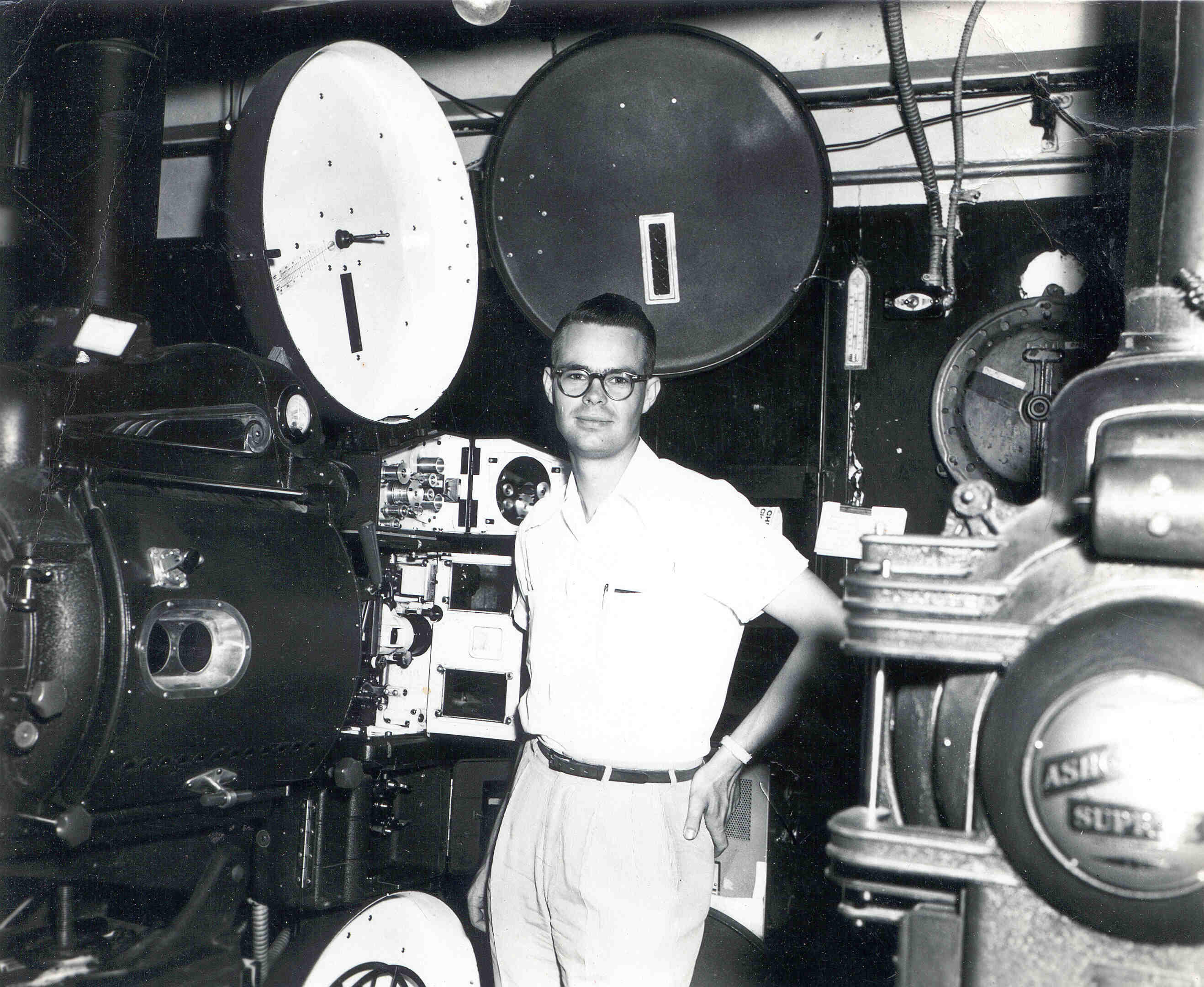
Cogerson: What was the difference between a good projectionist and a bad projectionist?
Bob Coats: The ones that did not fall asleep were the good ones. The projectionist booth had a two-minute warning saying the reel was about to run out. At that point they would watch for little white bubbles to appear on the screen….and then they would switch over to the new reel. Sometimes the projectionist would fall asleep, and the movie would stop….the booing from the crowd would normally wake up the projectionist. During the summer the projectionist had it rough. It was very hot in there…and there was no air conditioning. Heck they even had a bathroom in the room….and food was brought to them. So once they went in the projectionist booth they did not come out until their shift was over.
Cogerson: Any other memories or thoughts you want to share?
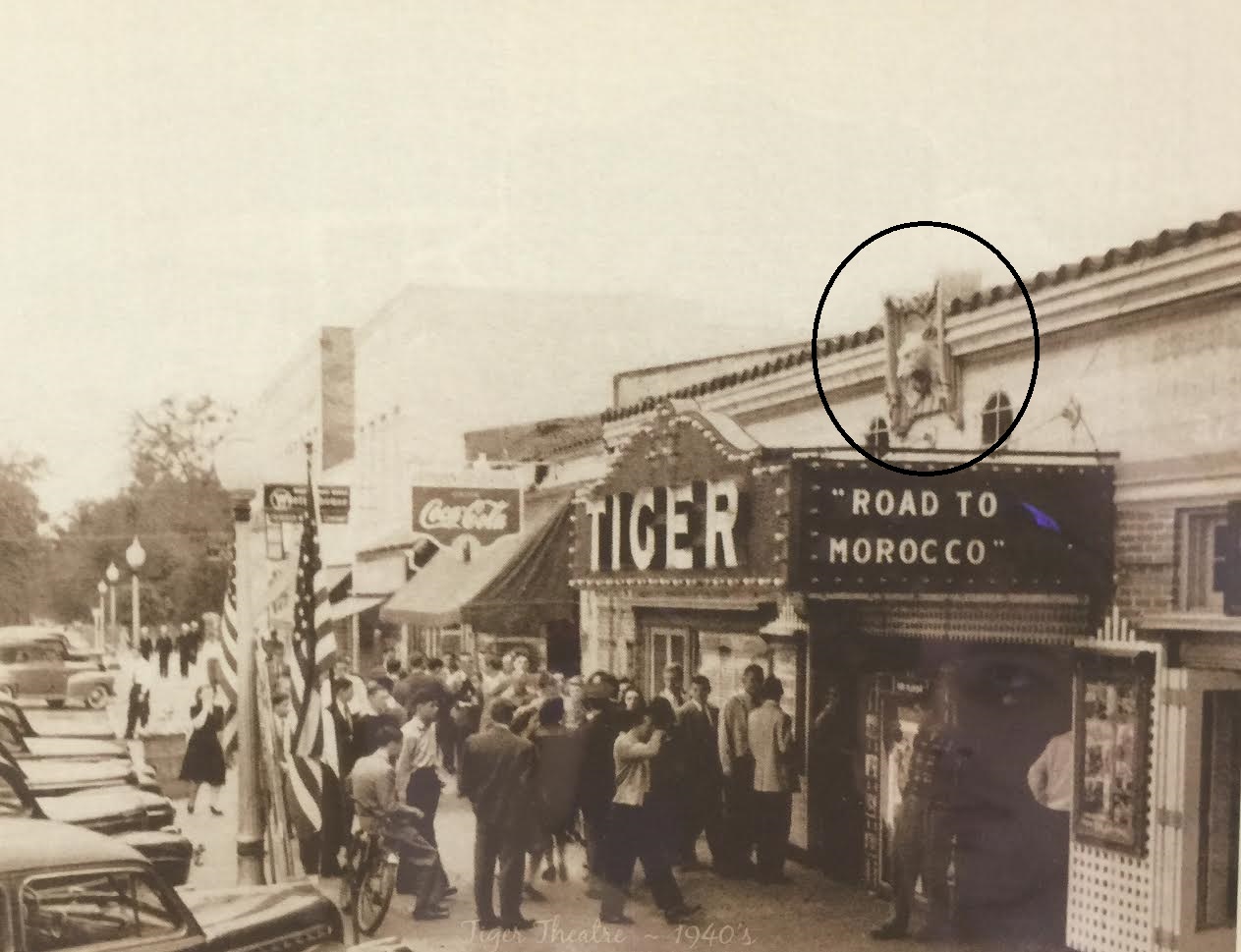
Bob Coats: Sadly there is not much left of the Tiger theater. It was opened in 1928 and stayed open for almost 60 years. Today it is a Gap clothings store. The only item left from the theater that is still there is the tiger architectural sculpture that is on the outside of the building. I did secure some of Tiger theater doors. I had two of them installed at my office and my oldest daughter turned another door into a coffee table that she keeps in her office.
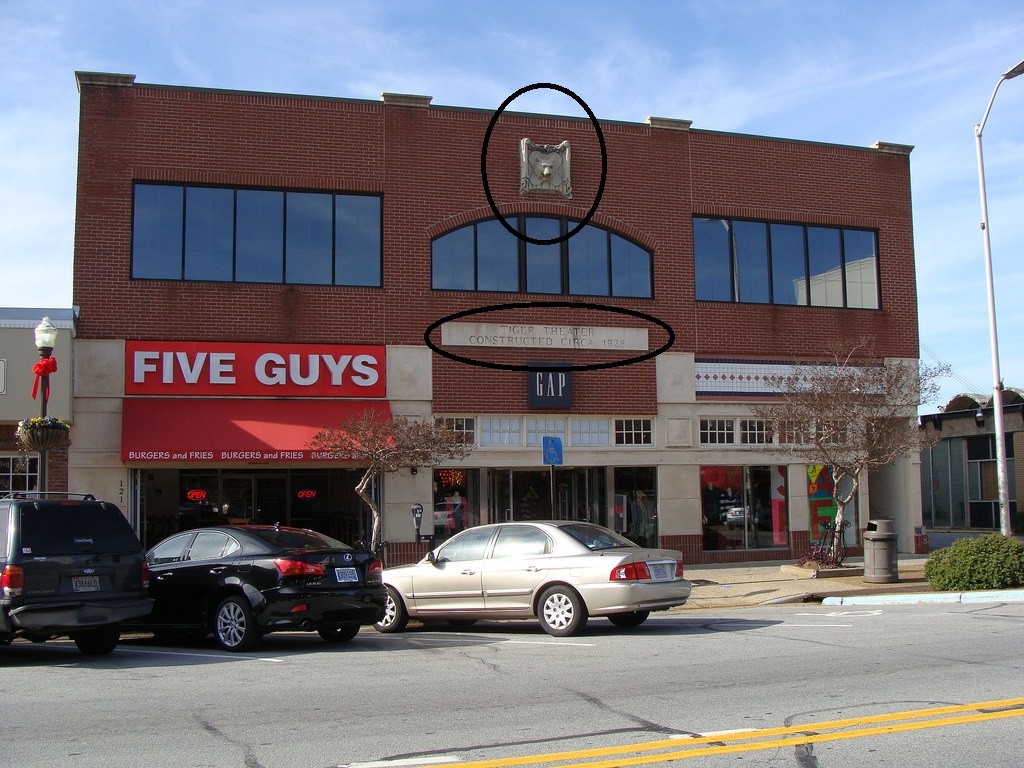
Cogerson: Thanks for all of this great information…..but I do have one final question…..your dad saw the death of vaudeville….did he get concerned when television started to keep movie goers home?
Bob Coats: My dad was not worried at all. First of all.. Hollywood was not going to go down without a fight. First came 3D movies which became very popular for a little bit. Then came CinemaScope which offered the biggest picture ever. We actually had to remodel the theater to be able to have the larger screen. Our seating capacity went from 715 to right around 600. Finally he felt that as long as Hollywood made quality movies then people will come out to the theater. He felt that going to the movies was a social event….and people would never stop coming. His words have come true. Even today with all the entertainment choices, people are still heading to movie theaters.
2021 update: Due to a question from Ronnie Cooper (6 June 2021): “Tell me, how did the theater handle the black patrons, or were they simply rejected?”
Bob Coats: Prior to integration in the South, the Martin Theater in Opelika had a balcony and a separate ticket booth and entrance for the blacks. Neither the Tiger Theater or War Eagle Theater in Auburn had a balcony or a way to separately accommodate blacks. There was a small theater in Auburn for blacks, but I don’t remember much about it, as I spent all of my time at Tiger. I do recall black patrons inside Tiger a few times, standing up at the back, but I don’t recall the situations or any fuss about it. Tiger did have black employees. Keep in mind, this was all well before James Meredith was admitted as a student to the University of Mississippi in 1962, or Auburn University’s integration in 1964.
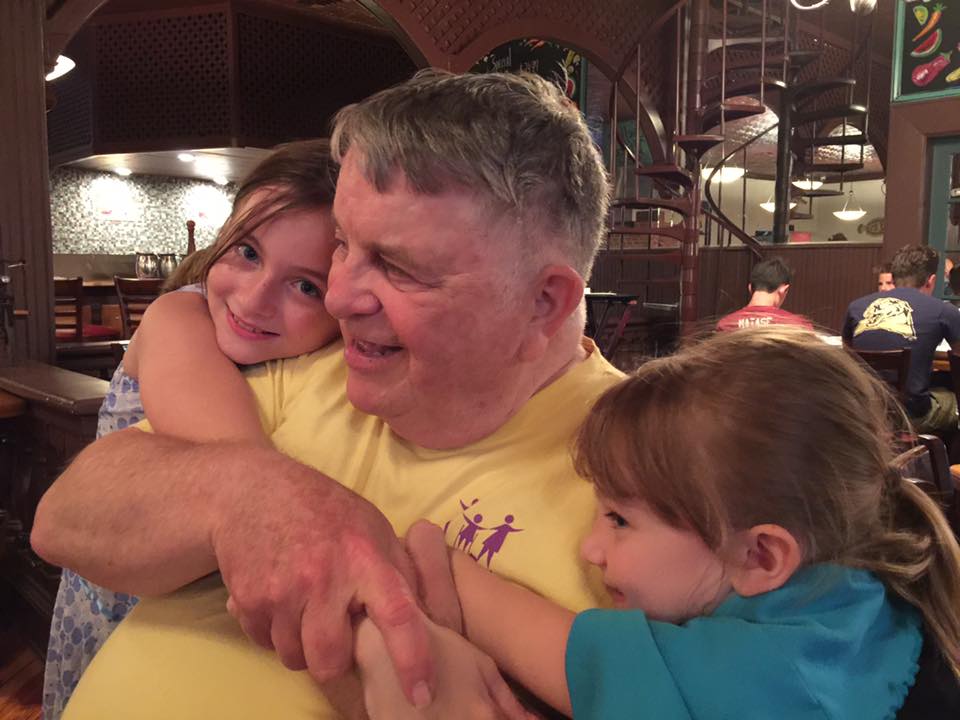
More Tiger Theater Photos
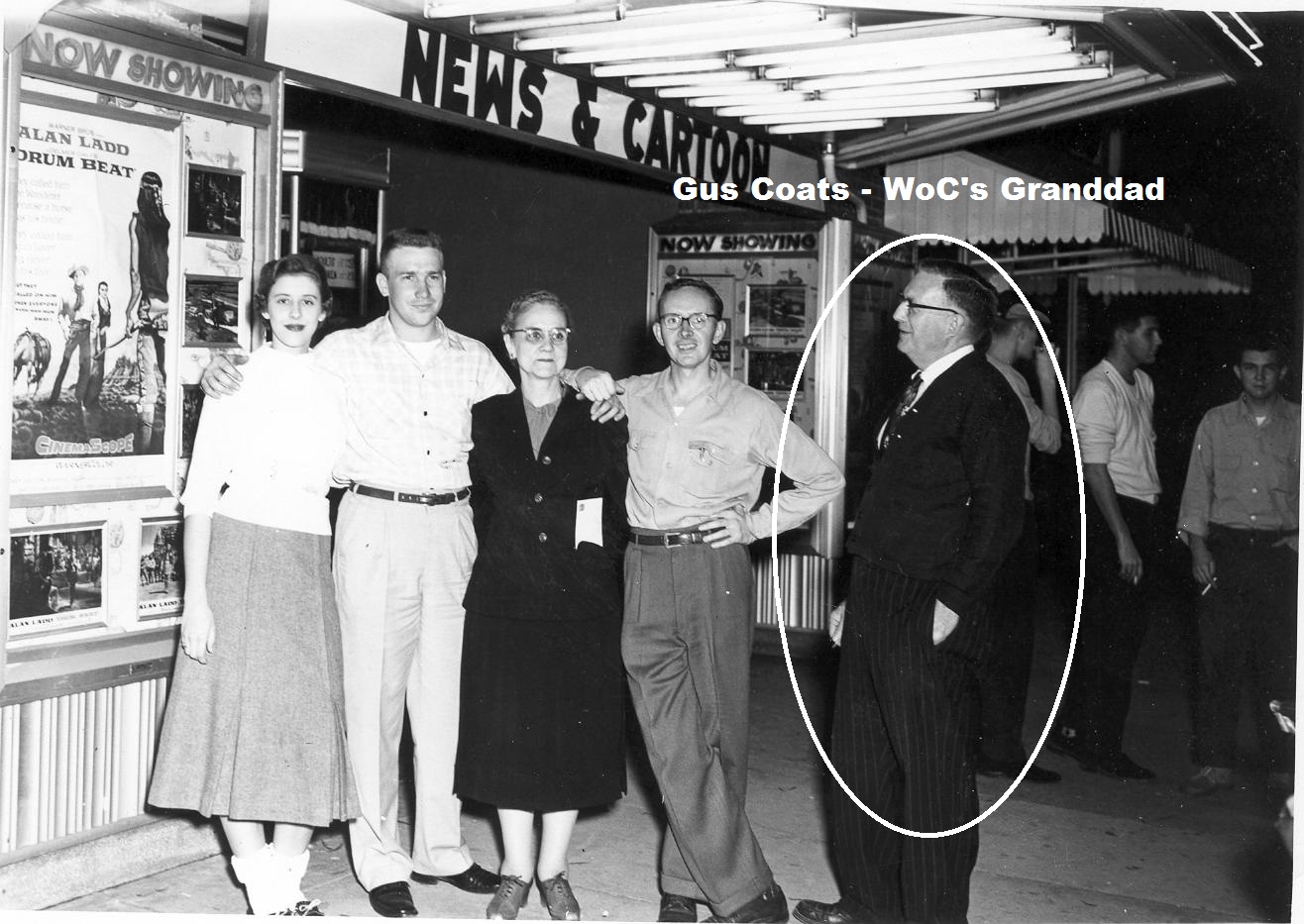
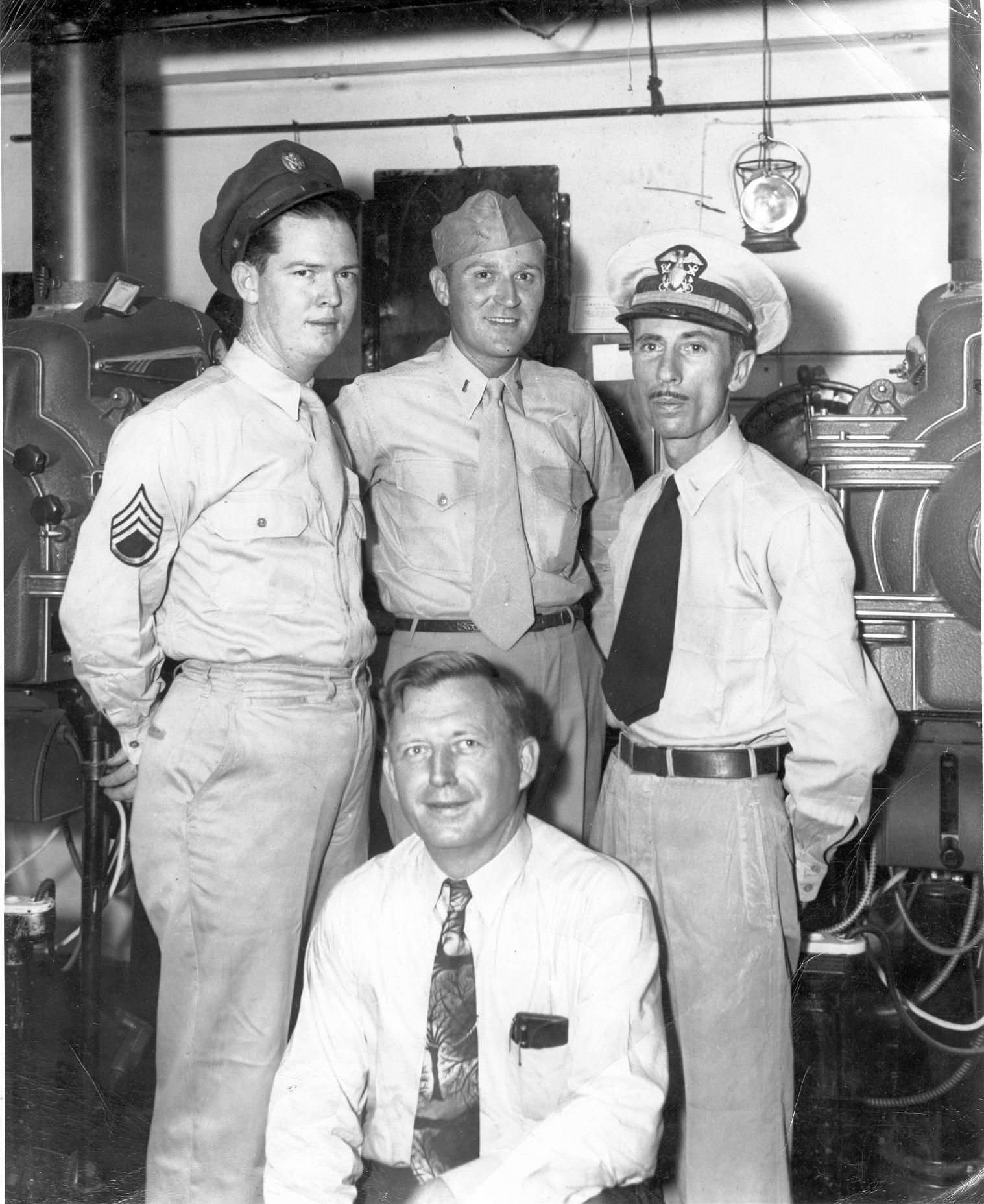
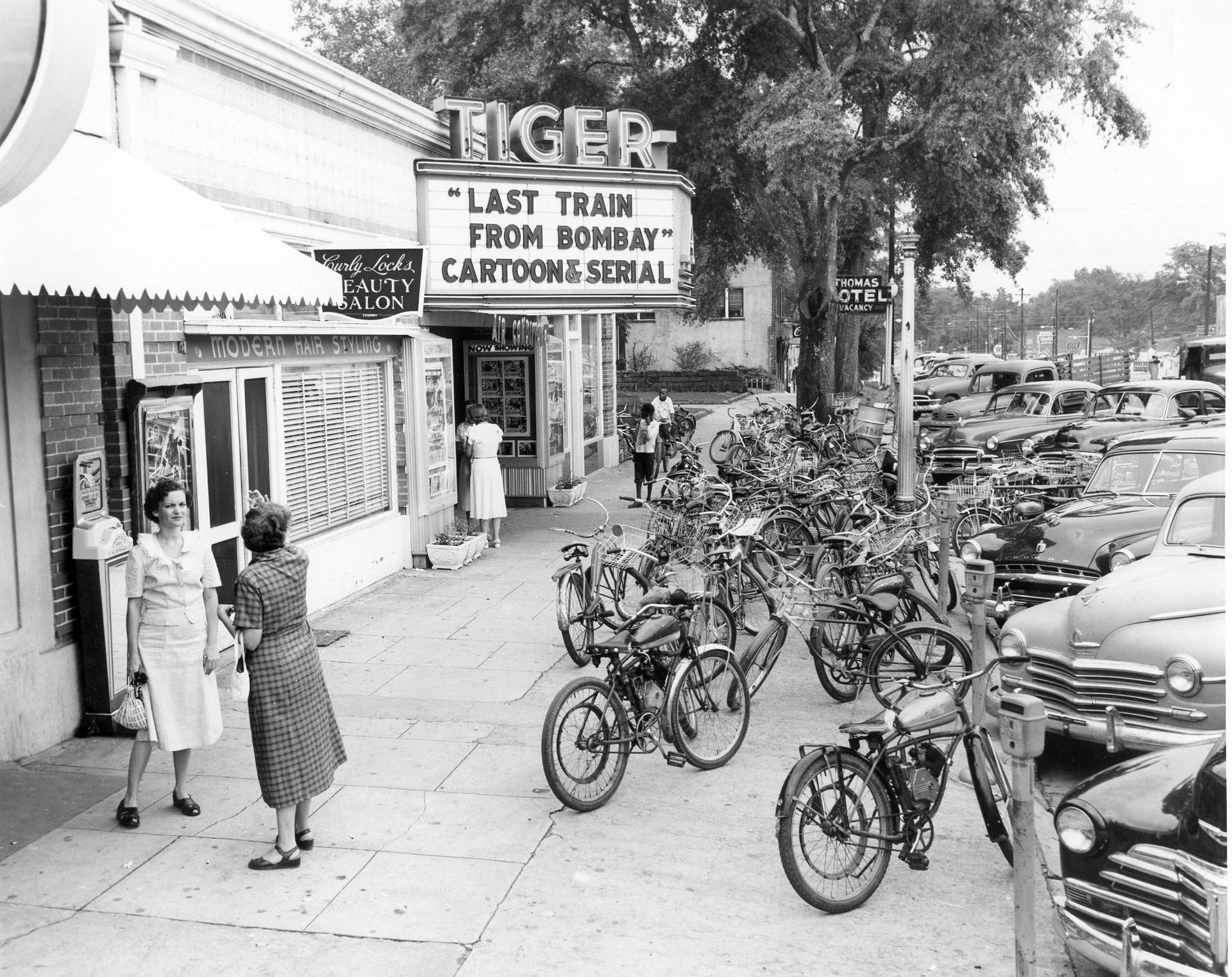
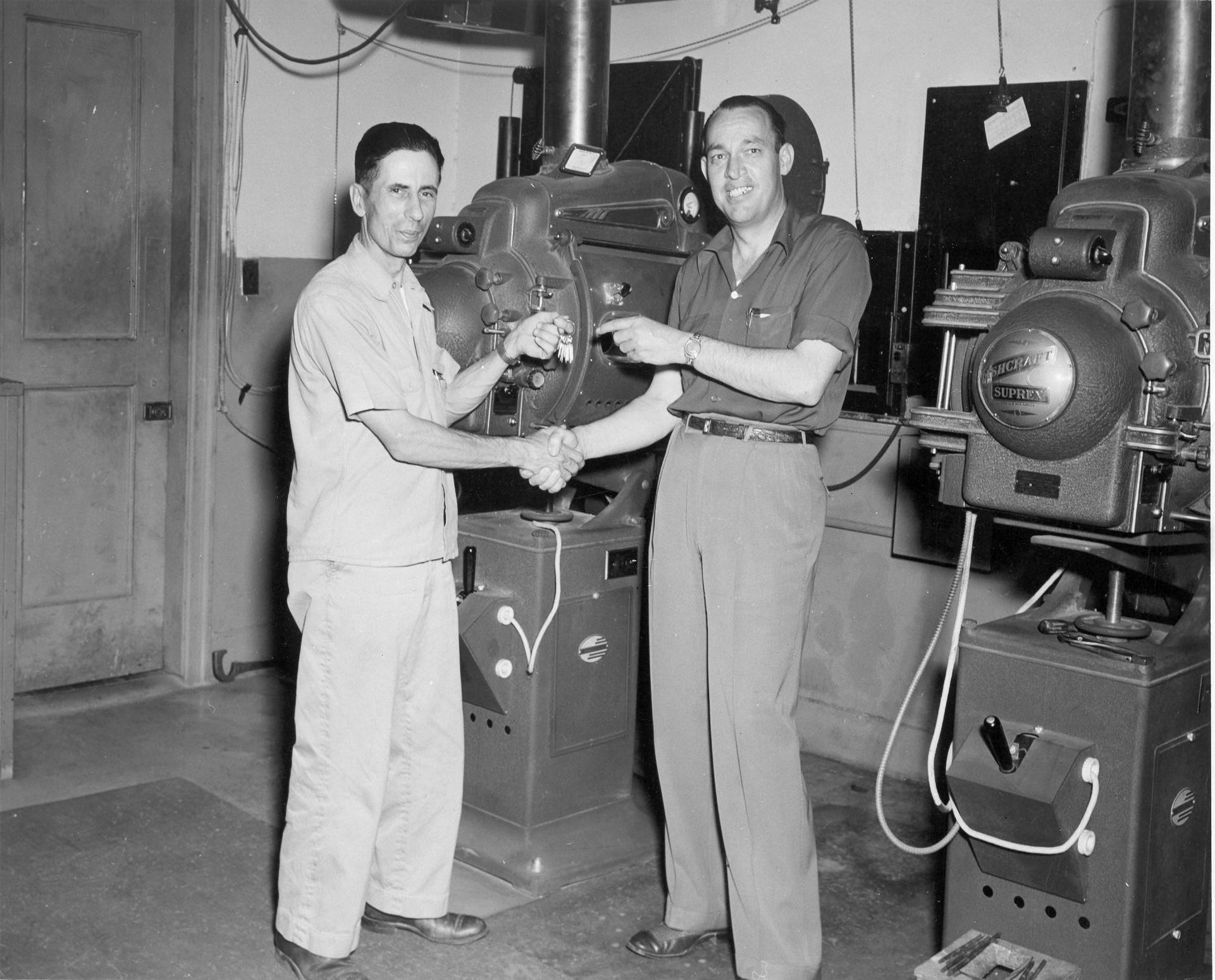
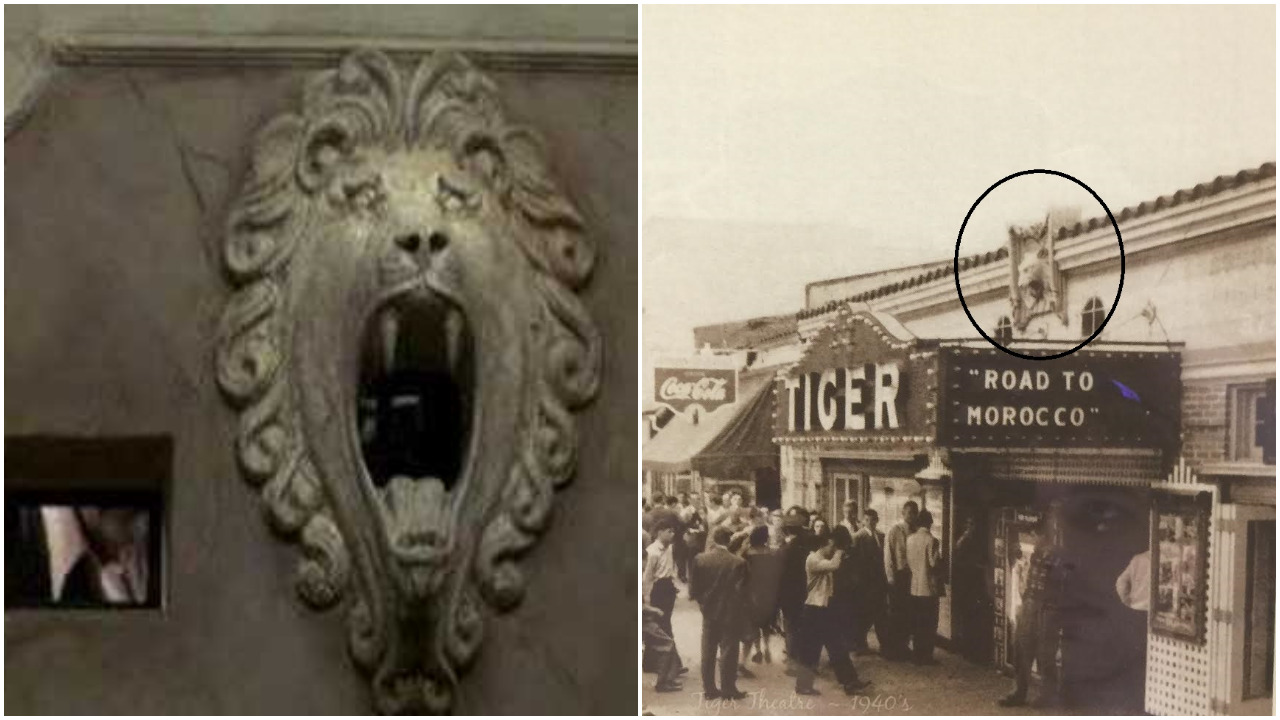
I remember the Tiger theater very well. Saw lots of movies there. I loved the pictures. Really liked seeing the Toomer Oaks in that picture. So many fond memories. Thanks so much for this it was like an early Christmas present.
Hey Auburn Class of 1963….glad a former Tiger theater patron found this page. Glad you liked the photos. My wife saw those Oaks and was glad to see them when they were so young. Appreciate the kind words and the visit.
Very well done. A nice snapshot of the movie world in the 1940s and 1950s. Cinema Paradiso is an excellent movie. I was thinking about that movie as I read this page. Thanks you doing this.
Hey Stein….glad to see another Cinema Paradiso fan out there. Thanks for the kind words…and the visit.
Hey Bruce, great interview with Father of the Wife of Cogerson! Always fascinating reading about those classic old cinemas. Some of them were really ornate. I remember one cinema in London, the Astoria, was very classy, the ceiling had ‘twinkling stars’ and around the huge screen was an Arabian Nights cityscape. Alas that theater no longer exists.
Did not know how hot those projection booths were, wow how did they cope? Those little dots on the screen and beeps on the soundtrack of a movie was a signal for the projectionist to change the reels. How does that work? Two projectors pointing at the screen? How do they make the transition so seamless? amazing.
Imagine being there when those Hope and Crosby films were brand new!
That’s enough mumbling from me. A great read Bob, good work Bruce, voted up!
Hey Steve….thanks for the nice words about this interview. Glad this interview brought memories of the Astoria and it’s twinkling stars. As for the way I understand it….a 90 minute movie would be between 5 and 6 reels. The projectionist would have two reels loaded up….at the end of 20 minutes they would seamlessly switch reels….and then load up reel 3 where reel 1 played….while reel 2 played….so yes two projectors with rotating reels. The Tiger room was pretty uncomfortable for sure. Hot….very little air movement….and the fear of fire constantly around….sounds like a stress free job…lol. Thanks for the mumbling.
Wow, that was so interesting. Thanks Bob for all your memories…….I remember when TV became so popular but movie stars felt TV was beneath them and would not appear on TV. I also remember going to the movies in Montreal. There were two movies with previews, cartoons and news between shows. Also if you happened to come in after a movie started you could sit through the movie again. THANKS SO MUCH FOR THIS SITE. AN EYE OPENER FOR SURE.
One other thing – apparently in the thirties there was a fire in a movie theater in Montreal and people trampled over kids trying to get out so kids were not allowed into the theaters until they were sixteen. I made up for missing movies when I was younger. I would talk friends into going to a movie (two movies) go to Chicken Chalet to eat and then go to another double feature – THOSE WERE THE GOOD OLD DAYS…….
Hey Bern1960. I know you are shocked that I have been pumping Bob for movie information for the last 11 years. I thought that the parents were able to leave the kids for the whole day was very interesting. I imagine the summers in Auburn were made much more enjoyable for kids…when they could watch movies all day…..eat candy and stay cool.
That is shame about fire in Montreal. Good old Chicken Chalet….maybe it is time to go back. I am sure we can manage to find a double feature movie to watch too. All we have to do is jump in the car and we will be there before we know it. Thanks for checking out our latest.
As a 50s filmgoer I can identify with much of what Bob Coats says in this well-conducted and very interesting interview. For example:
(1) As he says in those days a movie would do the rounds slowly and here in GB it could be a full year before we would get a new US movie. The protracted release schedule did of course mean that it could be a while before a distributor knew the extent of a film’s grosses whereas nowadays with saturation releases projections can be made the first weekend. [Indeed Bruce did one for Suicide Squad before its opening weekend!]
(2) The contracts system mentioned by Bob operated here too. There were 2 main cinema chains each of whom had an exclusive contract with a different set of film distributors.
(3 The first Cinemascope film shown here was The Robe (1953) released by Fox; whereas Paramount for example had its own new wide screen process called VistaVision and the first film that we saw in that format was Bing’s White Christmas (1954)
(4) Whereas cinemas could negotiate exceptions for the most vertiginous grossers such as Ben Hur (1959) the NORMAL policy here for the retention of films was that a flick could run for 6 days in city centre cinemas and then move out to the suburbs where it could be held for just 3 days after which the programme had to change. There were special kids matinees and morning showings for children but over here cinemas could not open on Sundays back then.
(5) Great photos. The film They Drive by Night (1940) advertised in one of them starred George Raft and was the very last movie in which 4th billed Bogie played 2nd fiddle.
In conclusion the contents of the Coats interview have given me a welcome opportunity to revisit memory lane and compare notes with someone who has had similar experiences to mine. Thanks Bob..
BOB ROY
Hey Bob.
1. Thanks for the nice words about my interview with Bob Coats.
2. I think Jaws was the first movie to try and release a movie in all theaters at the same time…back then it opened in about 400 plus movies…which was a record….now the big movies open in 4,000 theaters. Interesting that the movies were released in GB the same way that the USA did back then.
3. I am sure the contract system caused the studios to have some bidding wars for the most sought out cities and locations….that had to help out the owners of the theaters.
4. The Sunday hours listed in the interview were the hours in the 1940s….after the end of the war even those restrictions were lifted….sorry that you could not go to the movies on a Sunday when you were a kid.
5. I like you took great interest in seeing the movies being played in the pictures….the posters and the names on the marquees. That picture is the only one that is not of the Tiger theater.
Glad this interview took you down memory lane…thanks for such a detailed comment.
BRUCE:
1 In the 50s because of our security difficulties in Northern Ireland of which you are no doubt aware that required the presence of British soldiers in the province the Imperial Cinema in the centre of Belfast was given a special concession that allowed it to open on Sunday evenings for admission of only soldiers and their partners/spouses.
2 The Duke would have been very popular with the soldiers [naturally !] and repeat showings of his war films such as Sands of Iwo Jima and Flying Leathernecks would have been most welcome fare in the Imperial on those Sunday evenings of long ago..
3 Incidentally the Imperial was the cinema where in 1952 I first saw [on a weeknight of course !] Esther Williams’ Million Dollar Mermaid that we discussed in recent posts. I can also vividly remember standing in queues outside the Imperial for The Young Lions, Burt Lancaster’s The Kentuckian and Jimmy Stewart’s The Far Country. The Imperial building remains intact today but is used as a large shoe sales shop.
4 As you say many folk regretted not being able to visit the cinema on Sundays but the new releases came out in the city centre on the Mondays and I used to spend Sunday evenings walking past all the movie houses in Belfast and looking at the posters for the next week’s films so that I didn’t miss cinema-going on Sundays as much as I might otherwise have done.
5 I hope that you can now gauge the extent of the nostalgia that the Bob Coats interview has evoked for me.
BOB
Hey Bob….1. Very interesting information about Northern Ireland. It is amazing…that even in that stressful situation…that movies could still draw people in. 2. I can see Wayne being popular back then. 3. Thanks for sharing your memories of the Imperial. When I grew up…the theaters were pretty plain….but one summer….I spent with my grandmother in Portland, Oregon. One day we walked miles to a theater to see a movie….it was huge….had a stage in front….a balcony behind us….and balcony seats on the right and the left…..we saw A Bridge Too Far….and the theater probably had 50 people in there…but because it was so large it felt empty. I imagine it is a Gap store now…lol. 4. I can imagine that those movie posters got lots of attention back then….with little access to trailers…I imagine you really study those posters…as you tried to figure out what the movie was about. Glad this interview….brought out all of these great memories.
BRUCE
1 You being a movie buff I can appreciate how when going to see a Bridge Too Far in your youth you were probably so excited that you didn’t care about the long walk.
2 In the early 50s only a few privileged households in Northern Ireland had TV so that the demand for alternative entertainment back then was such that we had cinemas on virtually every road across the city and I would walk miles just to acquaint myself with them even though on most occasions I didn’t have the money to actually go inside. Standing outside simply gazing at the building was such a thrill !
3 Anyway the Bob Coats interview seems to have elicited a good deal of incisive comment and nowadays every time I look at the Recent Posts panel it appears to be largely monopolised with references to that page. So for now actresses and actors take a step backward and come forward and take a bow Mr Robert Coats !!